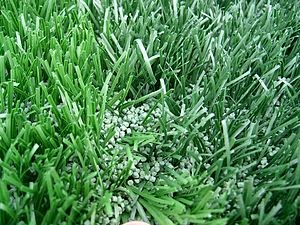Advantages
- Artificial turf can be a higher answer when the environment is especially hostile to natural grass. An arid setting or one where there may be little natural mild are examples.
- Artificial turf can stand up to considerably extra use than natural grass and can due to this fact be used much more frequently. This permits sports activities ground homeowners to generate extra revenue from their facilities.
- Supreme for vacation properties when upkeep of lawns is just not practical. Additionally it is a solution for aged residence-owners who find the maintenance of lawns an excessive amount of laborious work. Artificial turf may be vacuumed, broom cleaned or hosed over.
- Appropriate for roof gardens and swimming pool surrounds.
- Some synthetic turf techniques allow for the mixing of fiber-optic fibers into the turf. This might allow for lighting or commercials to be instantly embedded in a taking part in floor, or runway lighting to be embedded in synthetic touchdown surfaces for plane
Disadvantages
- Some synthetic turf requires infill corresponding to silicon sand and/or granulated rubber. Some granulated rubber is comprised of recycled automotive tires and will carry heavy metals which may leach into the water table. Different sources of infill might provide a safer solution.
- There may be some proof that periodic disinfection of artificial turf is required as pathogens are usually not broken down by pure processes in the identical manner as pure grass. Regardless of this, a 2006 study suggests sure microbial life is much less energetic in synthetic turf.
- Friction between skin and older generations of artificial turf may cause abrasions and/or burns to a a lot better extent than pure grass. This is an issue for some sports: for example, soccer during which sliding maneuvers are common and clothes does not fully cowl the limbs. Nonetheless, some third-era artificial grasses nearly completely eradicate this threat by way of polyethylene yarn.
- Artificial turf tends to retain warmth from the solar and can be much hotter than natural grass with extended exposure to the sun. This can be reduced by the appliance of water prior to make use of of the playing field.
- Compared with earlier generations of synthetic turf, trendy turfs are more everlasting installations and are not as simply eliminated and changed for individual sports. As an illustration, with earlier generations of turf, a multi-function stadium might have one turf set up for American football, roll it up, and replace it with a turf for, for instance, baseball or soccer. With sand and/or rubber infill and some solutions adopted for fixing the synthetic turf, trendy synthetic turf installations do not lend themselves to easy removal. This is part of the explanation why quick-pile turfs remain in use in indoor American soccer, which shares arenas with hockey and basketball groups, requiring simple elimination of turf when the game is finished.
- Line markings for differing sports are sewn into synthetic turf, making line markings permanent. In most cases with natural grass, line markings might be painted on with non permanent paint and eliminated (washed away) or it dissipates with rain or general irrigation. Line markings in synthetic turf for a number of sports activities are achieved by sewing in contrasting colors throughout manufacturing or 'reducing in' during installation. This creates a cluttered look and is usually unacceptable for professional sports. (Previous to the adoption of modern turfs, there were five stadiums hosting both MLB and NFL teams; as of 2012, there'll only be one, and there has additionally been a rise in soccer-particular stadiums on this time frame.) Temporary line marking solutions for artificial turf have not but been adopted.


